If you are looking wholesale lighting solutions, click here.
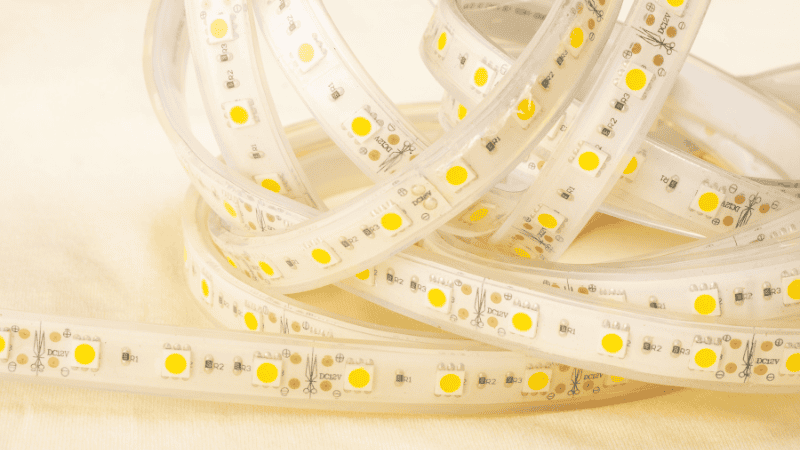
LED strip lights are all the rage right now, from aesthetic TikTok videos to mesmerizing commercial light shows. However, with so many options available online, it becomes challenging to choose the right LED strip for the project.
Here, we break down the most important things you need to know before buying LED strips, including their types, troubleshooting, maintenance, and much more.
LED strips are simply a bunch of small LEDs mounted on a strip-like circuit that provide exciting visual and aesthetic vibes to the place. LED strips come in a variety of types and sizes.
Manufacturers commonly distinguish them based on color, temperature, power (voltage or watts), and brightness. However, picking the right one for your project is more nuanced, which we will discuss.
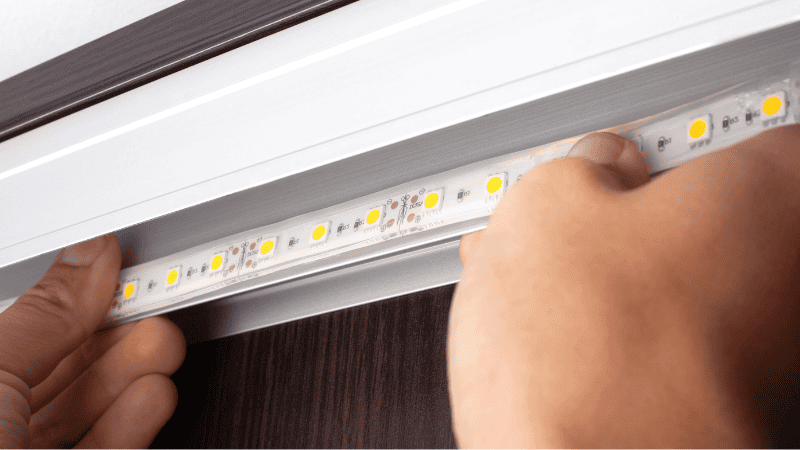
Here are the most common LED light strips you’ll see when shopping.
As the name suggests, these LED strips can emit only a single color. Though less versatile, they are much more economical and provide the required ambiance if installed correctly.
RGB LED strip lights have red, green, and blue diodes that can produce any number of color combinations, including pure white. It comes with a controller that allows many cool lighting effects.
The white color from RGB LED strips is often not up to the mark. It has hues of blue and a cheap look. So, you can try other popular options, such as the RGBW strip, which has four diodes in total: red, blue, green, and white. Similarly, RGBWW has a warm white light diode.
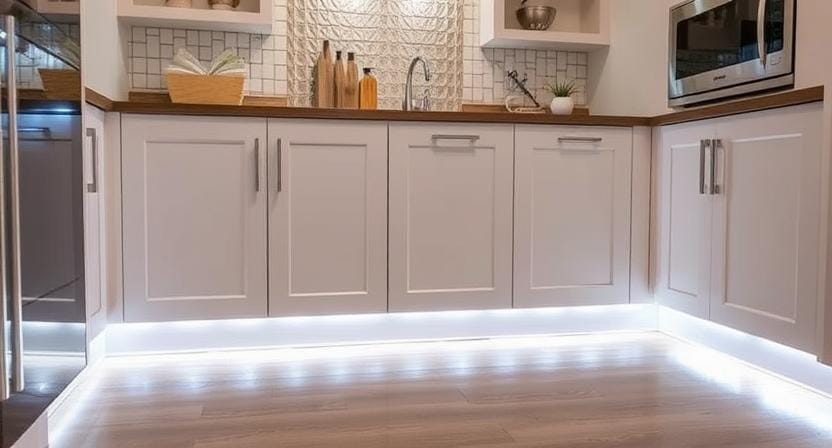
Smart LED strips are programmable, which simply means you can control individual LEDs separately. This is done by a microcontroller, which can create stunning animations and lighting effects.
Also known as addressable LED strips, they are compatible with smart home systems like Alexa and Siri. Some are even accessible through voice control and mobile apps.
LED rope lights are basic LED strip lights enclosed in protective silicon or rubber-based channels, making them a go-to outdoor lighting choice.
Here are the most critical things you should consider when sorting through the LED strips.
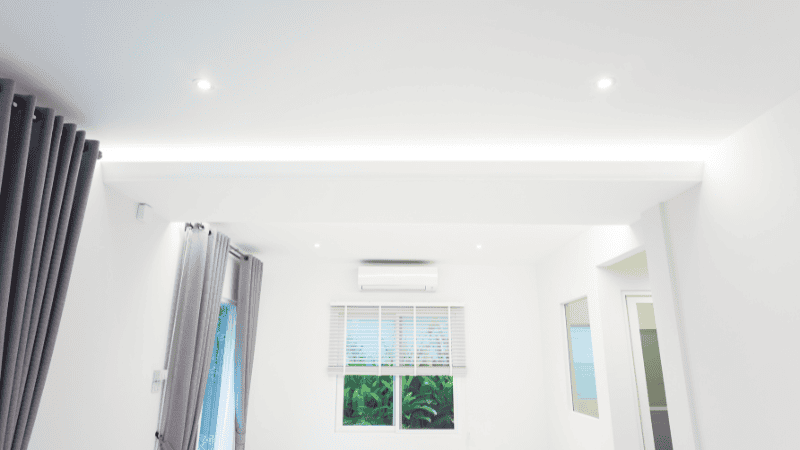
An average buyer might not pay much attention to the label on the LED lights, but the numbers you see on the LED chip tell a lot about the type and size of the chip on a strip.
For example, a 2835 SMD LED strip means the chips are 2.8 mm by 3.5 mm in size. SMD is short for surface mounted, a connection common in LED strips.
We recommend 2835 and 3528 SMD LED strips for most purposes because they consume less power, and their light output is still comparable to bigger LEDs.
| LED SMD Chip | Surface Area (mm^2) | Lumen Output (Lumens-lm) |
|---|---|---|
| 3528 | 9.8 | 100-240 |
| 5050 | 25 | 240-400 |
| 2835 | 9.8 | 100-140 |
| 4014 | 5.6 | 60-100 |
You’ll notice the number of LEDs per meter or foot immediately on any LED strip packages. Typically, the options available are 15, 30, 60, 90, and 100+ LEDs per meter. The higher the number of LEDs, the smoother the light display and the better the overall ambiance.
The closer the LEDs are, the more they’ll look like a constant light source instead of individual LEDs. It plays an important role in smart LED strips, as the light animations and transitions are seamless.
However, higher density isn’t always the best economic choice as the prices soar as you look for higher density options. We recommend 30 and 60 LEDs per meter as they give the best ambiance and accent lighting effect.
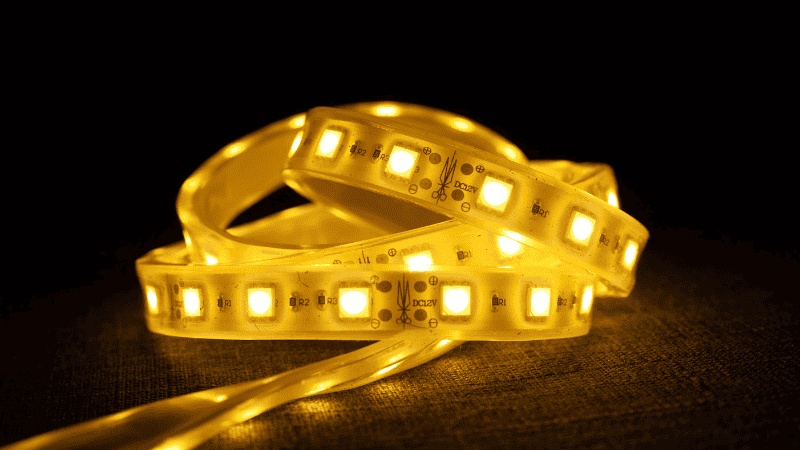
Choosing the right color is crucial if you want long-term satisfaction. Identify your lighting goals based on the area you plan to light up and the type of colors you want.
Single-color LEDs, especially white LED strips, give off a higher-quality aesthetic. Even though RGB LED strips can produce white light, the resulting light has a blueish and greenish tint to it.
So, if you plan to light up kitchen areas or a bedroom where you want mostly shades of white, we recommend using Tunable White LED strips. It’s a dynamic lighting solution that lets you control the color temperature from a range of 2700 K to 5000 K.
RGB strip lights are best when you want funky, retro, and fun aesthetics in your place and get creative with colors.
Correlated color temperatures (CCT) are the shades of white you often observe in nature. Early sunrise or candle flame gives off warm white light with a yellowish and reddish hue that falls between 2500 and 3200 Kelvin (K).
In clear weather, a bright, full sun gives pure white around 4000 to 5000 kelvins. Tunable LED strips can emit a wide range of color temperatures, allowing users to adjust it to their liking.
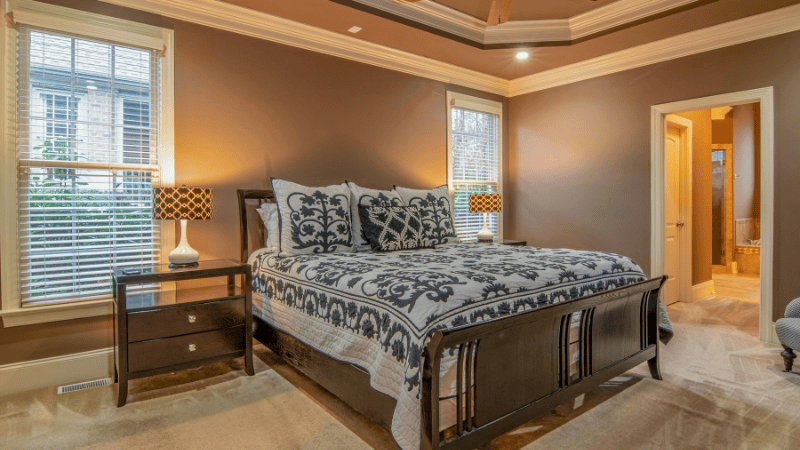
CRI is a rating that compares the ability of artificial lighting, like LED strips, to display colors compared to natural sunlight. The sunlight gives the most accurate and vibrant display of colorful objects, and that’s why it has a perfect 100 CRI.
Most LED strips you find on the market are within 80 to 90 CRI range. Anything lower than this significantly reduces the lighting quality.
Suppose you plan to use LED strips in areas where moisture and humidity can come in contact with the strips; then we recommend going with waterproof LED strips. Sure, they are a bit more expensive, but they will prevent short-circuiting and potential hazards.
Most LED strips are available in three Ingress Protection (IP) ratings, which simply represent their ability to resist water:
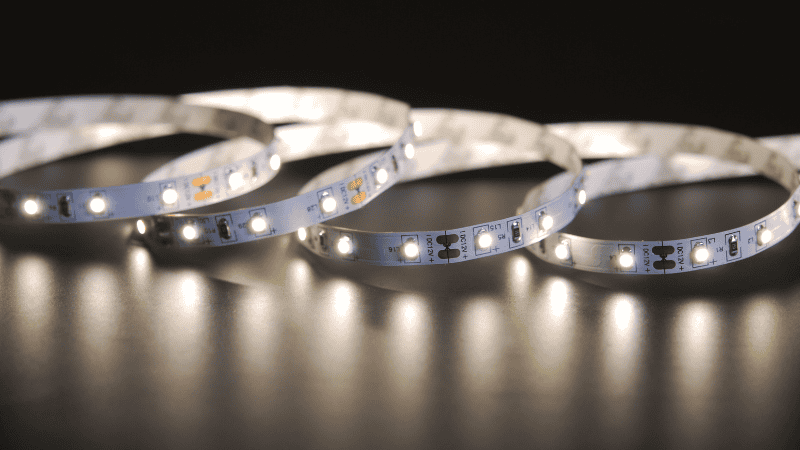
However, keep in mind that these are not designed for use in underwater applications.
Let’s talk about voltage first. LEDs run on a DC power supply; you’ll typically see options such as 5 V, 12 V, and 24 V LED strips. Lower voltage doesn’t mean the LEDs will be dimmer than higher voltage ones. It simply tells the number of LEDs able to run on said power supply.
A 5V strip can run 100 LEDs, 12 V can run 230-240 LEDs, and 24 V can go all the way up to 460-480 LED on a standard 2 amp current supply. The 5V LED strips are useful for most decoration cases, as they can directly connect to microcontrollers (Arduino) or USB chargers.
The voltage of an LED strip tells only half the story, as the total power (wattage) is actually voltage times current (amps). So, you can increase the power by simply increasing the current using an additional LED power supply.
It’s possible to connect an already lit LED strip with another power supply to increase the number of LEDs connected to a strip, which is also called power injection.
But if you are running a higher number of LEDs on a lower voltage LED strip like 5 V, we recommend adding a bigger power supply in the beginning, as it’s much safer and more convenient.
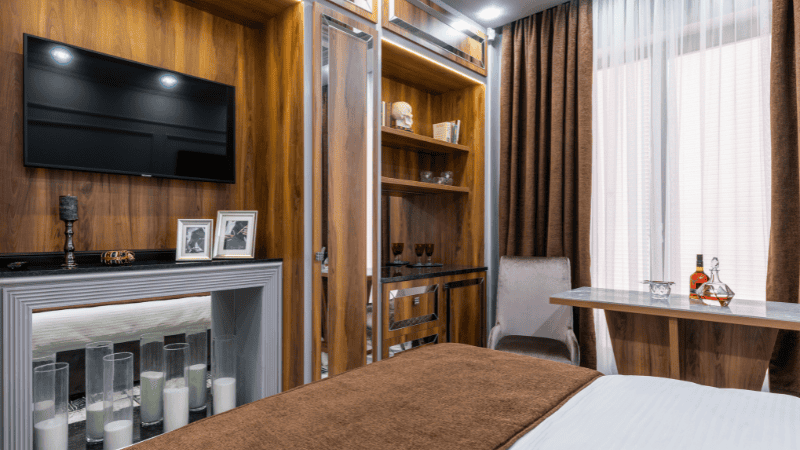
Another thing to remember is that higher power may give you more bright light, but it can also heat the LEDs and shorten their life.
You can also look for Luminous Efficacy, measured in lumens per watt, typically mentioned on the package. It shows a clearer picture of what to expect instead of relying on a higher power.
We recommend going for higher voltage strips like 24 V and adding a TRIAC dimmer or similar compatible LED dimmer to adjust the brightness. That way, you’ll always control your lighting needs without being restricted to power rating.
RGB and smart LED strips also require controllers apart from regular power supply. These are mini-computers that give instructions to the LEDs. A remote control usually operates them.
Some advanced controllers need to be connected separately with a power supply but can connect to mobile phone apps or home assistance devices like Alexa.
Microcontrollers like Arduino, D1 Wemos Mini, ESP32, etc can also control smart LEDs. A good thing about these is that you can actually write code and program mesmerizing LED light animations, offering complete control over your lighting project.
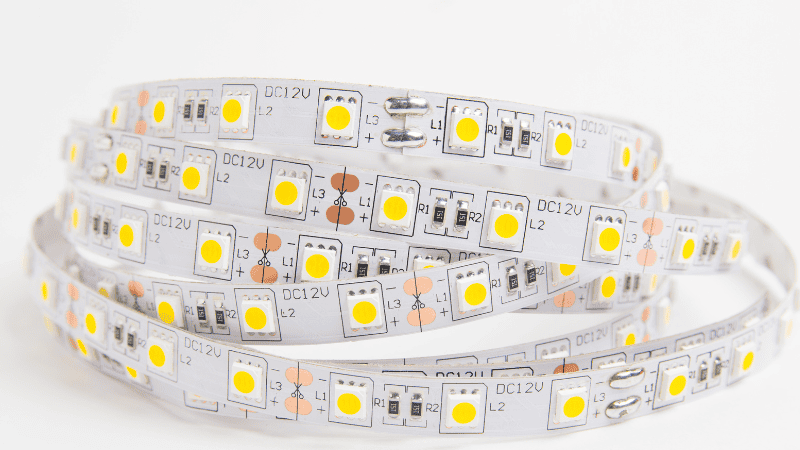
If programming isn’t your cup of tea, then you can always go for pre-written codes and applications like WLED. It’ll allow you to choose from tons of really exciting lighting animations.
LED strips almost always come in 16 ft or 5-meter rolls, but the good thing is they are designed in a way that you can cut and reconnect them to your desired length.
You can cut them where the copper is exposed, also marked by a dotted or dashed cutting line. Cut exactly in the middle of Cooper circuits using regular scissors.
Once cut, you can solder the connection and make sure all the connections are lined properly. If soldering is not your thing, you can also get a plastic connecter that can easily clip two or three LED strips together.
Diffusers are aluminum (any material) channels covered with translucent covering in which LED strips can be secured, and the resulting light gets diffused, and the light output becomes smoother.
The aluminum rail or channel also helps dissipate the heat from the LED strip and protects it from any impact. If you want something that can enhance the lighting effect and increase the life span, aluminum diffusers are the way to go.
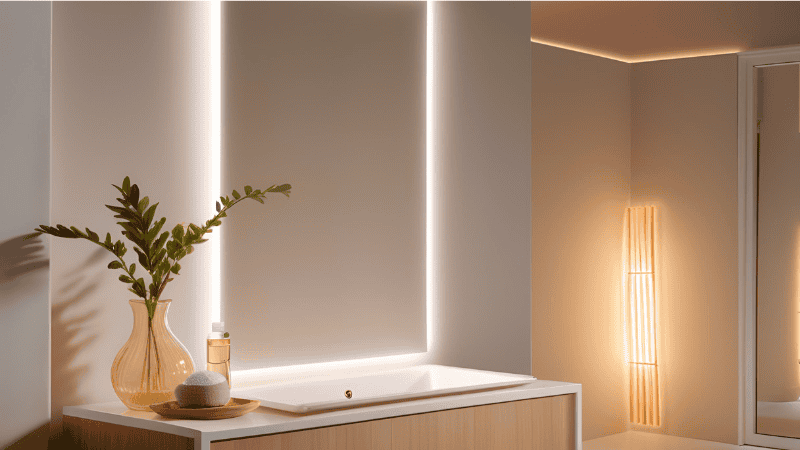
LED strips already come with a sticky adhesive at the back. The 3M or 200MP adhesives are higher quality and longer-lasting. You can also use clips or hot glue to secure the strips or diffusers in place. Just make sure not to damage the strip while mounting it.
If, for some reason, you want to remove the LED strips, use a floss thread or something similar to run underneath the surface, and the strips will come right off.
Budget is always a genuine concern when it comes to any lighting project. The LED strips come in various prices, and their output may look similar, but cheaper ones usually burn out easily. For safety and long-term profit, we recommend using UL/CE-certified LED strips for your project.
Installing LED strip lights is a pretty straightforward process. All you need is a little hands-on experience, the right tools, and the step-by-step guide mentioned below.
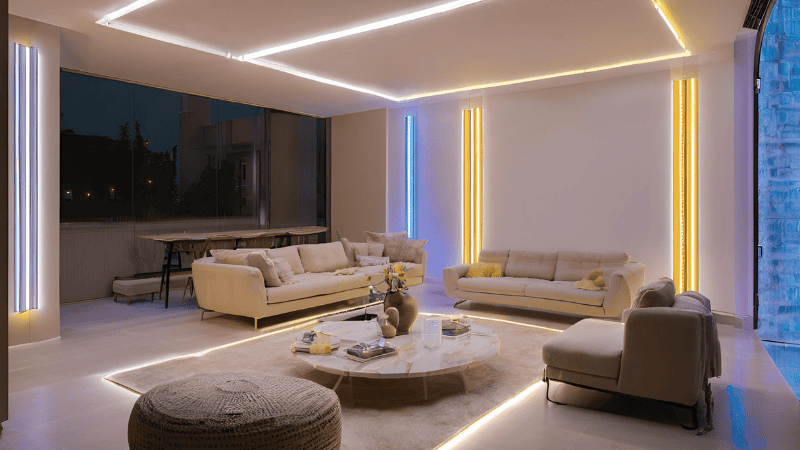
Before moving on to installation, we need to check if everything is operational and running as desired. Connect the power supply, controller, and LED strips together. Use an adequate power supply of the right voltage.
If the LED strips are long or have a higher LED density, plan beforehand whether you want a second power supply in between the strips or use a bigger one at the start.
Once done, run it for a few minutes and try different options. However, don’t keep it on for long if the LED strip is still rolled in a spool, as it can quickly get heated up.
Use measuring tape to measure the length of the wall or wherever you want to put the LED strip. Make sure you have the required length of LED strips. If you need longer or shorter LED strips, just cut and connect them using solder or plastic connectors.
Once finished, test run the LED strips again and make sure everything is running smoothly.
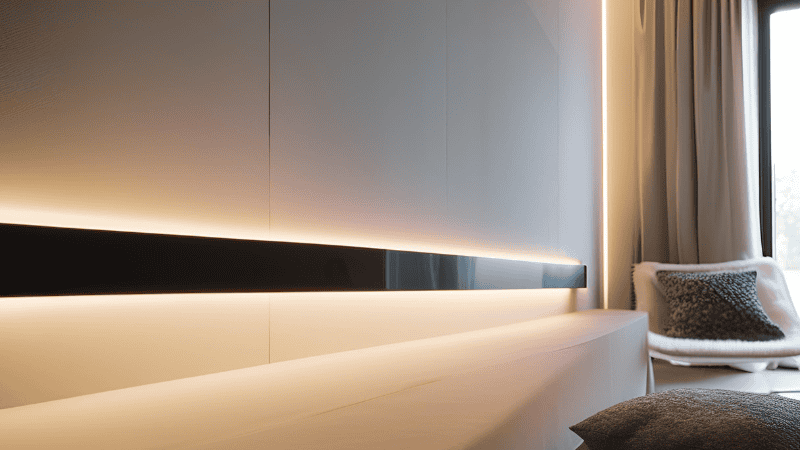
Clean the surface where you want to mount LED strips with sandpaper or a scraper. This is necessary to remove any bumps or imperfections on the surface, as mounting the LEDs here will really expose them. Also, it helps with adhesion as the stickiness of tapes lasts longer on cleaner surfaces.
You need to be prepared for bends and corners. Ideally, it’s recommended to simply avoid bending the LED strip as it can cause damage. However, a slight bend or loop in the circuit won’t make a difference.
You can also cut the strip near the bend and connect it to the other strip using connector cords. That way, the bend is covered by a connector wire instead of an LED strip.
The LED strip comes with adhesive tape at the back. Just use hot glue to keep things in place for a more secure mounting. If you use aluminum diffuser channels, they will come with mounting brackets or a wire system to hang them from the wall.
| Mounting Method | Description | Pros | Cons |
|---|---|---|---|
| Diffuser Channels | LED strips secured in robust aluminum channels, mounted on walls. | Sturdy and durable | Higher time and cost investment |
| Wood Staple | LED strips affixed to wood surfaces using staples. | Simple and cost-effective | Limited to wood surfaces |
| Adhesive Backing | Quick and affordable attachment on flat surfaces using adhesive. | Fast and inexpensive | Requires proper prep to prevent tearing |
| Cable Clips | Easy installation for long LED strip runs using regular wiring cable clips. | Secure and straightforward | Best suited for long runs |
If you follow steps one and two clearly, then this last step will be a breeze. Make sure the LED strips are properly mounted, then connect them to the controller and main power supply.
LED strips are the epitome of creativity and ingenious lighting designs. Here are some cool ways to experience the maximum potential LED strips have to offer.
Ambient lighting serves as general illumination in a space. Typically, recessed and downlight fixtures are employed for this purpose, but LED strip lights enclosed in a high-quality diffuser can serve as an excellent alternative. They provide a minimal yet futuristic vibe to the place.
Accent lighting is typically used to illuminate a particular artifact or object, enhancing its design and the overall aesthetic of the space. The flexible structure and small footprint of LED strips make them an excellent choice for such lighting.
Who says LED strips are only for show? You can use them for specific tasks, such as lighting up the kitchen cooking station or brightening up that study table.
Modern research shows that LED lighting has a significant effect on mood. Use LED strip lights to adjust the vibe of the place. Whether you’re working, relaxing, or aiming for a romantic atmosphere, the sky is the limit.

Studies show that LED strips can significantly affect people’s moods more than regular light fixtures. Similarly, a well-designed LED strip lighting setup can improve overall sleep hygiene, leading to better health.
LED strip lights are extremely efficient when it comes to power consumption, granted that proper heat dissipation is maintained.
There’s no doubt that RGB LEDs and addressable (smart) LED strips are among the most versatile luminaires, offering thousands of colors and animations to choose from.
Extremely easy to install, without the need for mountings or cutting holes in the walls as required with other lighting fixtures.
The smart LED strips are easily programmable using microcontrollers, apps, and computers, making them an exciting and creative lighting option.
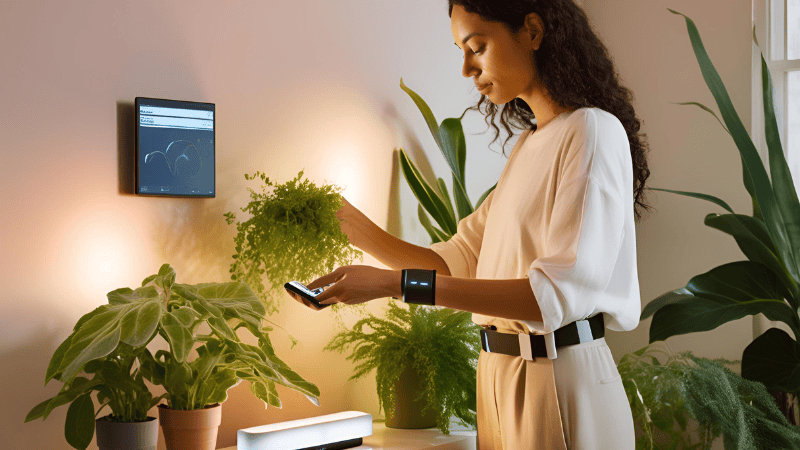
Check the power source and connections for proper voltage. Inspect the power supply.
Examine for loose connections or damaged insulation. Confirm correct polarity and soldering.
Inspect individual LEDs for damage, ensuring the right RGB sequence and connections.
Verify dimmer switch compatibility, proper setup, and wiring.
Investigate loose connections, power fluctuations, or incompatible controllers. Ensure a stable power supply.
Troubleshoot the LED controller for malfunctions or incorrect programming. Reset or replace as necessary.
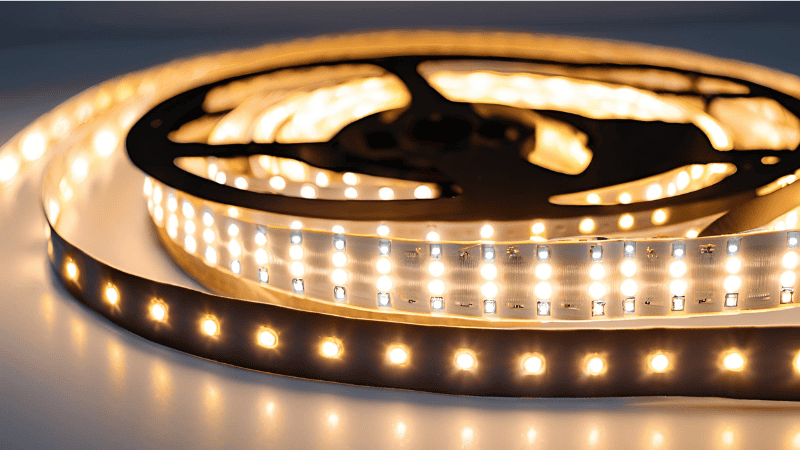
LED strips are pretty much maintenance-free, but here are a few things that may help you get better performance.
After prolonged use, dust may settle on the LED strip, potentially damaging it. Turn off the power supply and gently clean the strips using a dry, lint-free cloth with a patting motion. Avoid rubbing the cloth, as it can damage the circuit.
Don’t leave the LED strips on unnecessarily, as they can heat up and shorten their lifespan. Aluminum channels are a great way to prevent this, as they act as a natural heat sink.
A good thing about LED strips is that you can always replace the faulty component without changing the entire strip.
You can buy the best LED strips by considering the following points.
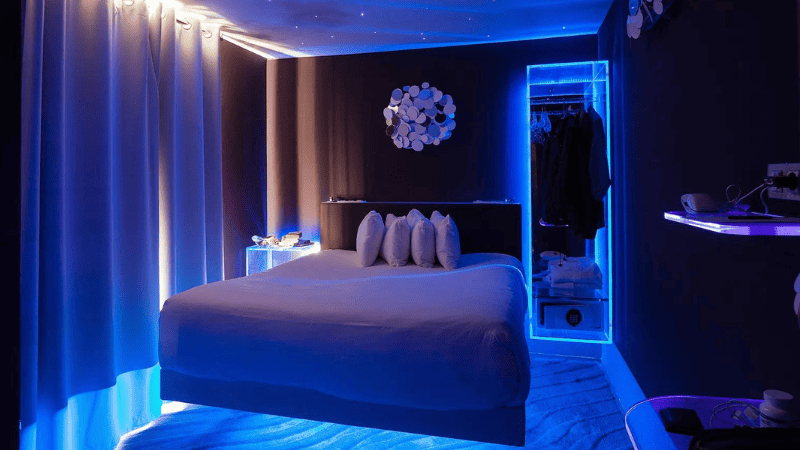
The quality of LED strip lights depends upon many factors. However, here are the most basic things you must consider.
Consider these factors when deciding between cheap and expensive LED strips, considering your specific needs and budget constraints.
| Factor | Cheap LED Strips | Expensive LED Strips |
|---|---|---|
| White Color | Cheap white color with bluish, greenish or purplish hue. | Pure white with authentic color temperatures. |
| Color Accuracy | Lower color rendering index (CRI) | Higher CRI, providing accurate color |
| Durability | Often less durable materials, Quickly heat up. | High-quality, durable construction |
| Waterproofing | Limited or no waterproofing | Often waterproof or water-resistant |
| Longevity | Shorter lifespan | Longer lifespan, reducing replacement costs |
| Brand Reputation | Unknown or lesser-known brands | Reputable brands with proven performance |
| Features and Controls | Basic features, limited controls | Advanced features, compatibility with smart systems |
| Warranty | Short or no warranty | Longer warranties, reflecting confidence in quality |
We are sure this buying guide will help you choose the best LED strip for your project. Remember, these nine considerations are just the beginning.
However, once you master the basics, you’ll be in a much better position to make an informed decision. Dive into the world of LED strips and bring your projects to life.
As the bridge between the North American market and elite Chinese lighting products, Risun Corp brings over 13 years of expertise in supply chain management to tailor lighting solutions for your business.
Benefit from our extensive market insight and client-oriented approach. Whether you’re a wholesaler or importer, Risun ensures personalized service, competitive pricing, and an extensive range of luminaires. Indoor, outdoor, and commercial lighting fixtures, you name it.
Light up your success—partner with Risun Corp. Contact us today!
Comprehensive Lighting Solutions for MRO Wholesalers and Professionals
send your inquiry
Hi, I'm the author of this post, and I have been in this field for more than 15 years. If you want to wholesale lighting fixtures or lighting related product, feel free to ask me any questions.
Learn More >>Download our catalog to view all of our lighting products.
Ready to get started ?
Send Your InquiryOur team will get back to you promptly

please
download
Get notified about new products
Our team will get back to you promptly!
Add your first comment to this post